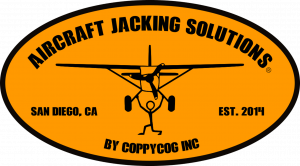Frequently Asked Questions
The jack is intended for the purpose of servicing wheel bearings, replacing tires, replacing brake pads, replacing landing gears, verifying torque of main gear attachment bolts and gear shims are tight and secure, installing larger tires, and making W & B activities easier. Some of these activities are normally difficult or impossible to do with other jacking systems.
The belly pad system allows for the gear legs to be changed and for a thorough inspection of gearbox main bolts on tail wheel aircraft. These activities would not be possible using other jacking systems.
The flat gear lift pads are ideal for lifting aircraft to install 29″ tires on certain aircraft. (See the Safety Protocol on the homepage for more information.)
Both systems will safely raise the aircraft. It’s up to personal preference on how the owner/user wants to utilize the Coppycog Jacking System.
The area where the belly pads are placed is one of the most robust areas of the aircraft, since this is where the landing forces are absorbed in the fuselage. This jack has 1/4″ rubber pads attached to the lift plates to eliminate movement and scratching of paint. It has successfully been used to lift hundreds of aircraft, and no damage has been reported.
The lifting capacity of the entire jack system, including the use of Flat Gear or Belly Pad attachments, is 3,800 lbs. As a point of reference, the gross weight of a Cessna 206 is 3,300 pounds.
Yes, all lift components above the floor jack have a lifetime warranty to the original owner. The floor jack may need “O” ring replacement or minor maintenance from time to time. Parts for this and or similar work have a lifetime warranty to the original owner.
The jack’s safety stop system should always be used to prevent potential slow bleed down of the jack or abrupt lowering by an unauthorized person attempting to lower the jack during routine wheel maintenance. The best practice is always to use secondary support.
No, safety first.
No, you should never place your body and any part under a suspended load. The jack is designed with a safety stop mechanism that should always be utilized when lifting your plane. The actuator lever/knob for engaging this safety system was placed near the pump handle to ensure the operator was kept out of harm’s way. Safety first!!
No, as long as the lift pads are both centered under the flat gear legs, the nylon inserts will not scratch or chip paint. They are designed to slide into position as the aircraft is raised and will not pinch or damage the brake lines.
This is due to a low hydraulic fluid level in the jack. Simply remove the floor jack cover located forward of the pump handle and check the fluid level. (Refer to procedure in operating instructions)
It’s always a good habit to wipe off any excess oil in the area where the belly pads will be contacting the aircraft belly. The protruding rivet heads of your aircraft will slightly embed into the ¼” thick rubber pad attached to the lifting plate and do an excellent job of eliminating slipping potential.
The best and safest solution is to service one gear leg at a time and ensure there are always three points of contact with the floor, i.e., nose gear tire, opposite main tire, and place an adjustable stand under the wing rib where the strut and tie down ring is located. Always use secondary support.
Ideally, the upper portion of the gear leg pads should be equally spaced from one another and held roughly 5” to 6” below where the gear leg enters the fuselage. If larger tires are being installed (29”), the pads should be as low as possible, 8”-10”, to ensure adequate tire clearance.
Initial jack setup prior to lifting is critical. Always center the jack “T” stand directly below the center line of the aircraft belly. There is typically a row of rivets running tail to nose in this area. Be sure each slide tube is extended equally, as indicated by the stamped hash mark and number on each slide tube. Beyond that, ensure the fuel loads are equal. This can be achieved by placing the aircraft fuel selector on both (is so equipped), and over a short time, fuel loads will equalize. Under normal conditions, a weight (5-gallon bucket with “S” hook and ballast added) can be hung from the opposite wing tie down. This will raise the heavy wing condition caused by unbalanced fuel, installed equipment, etc.
